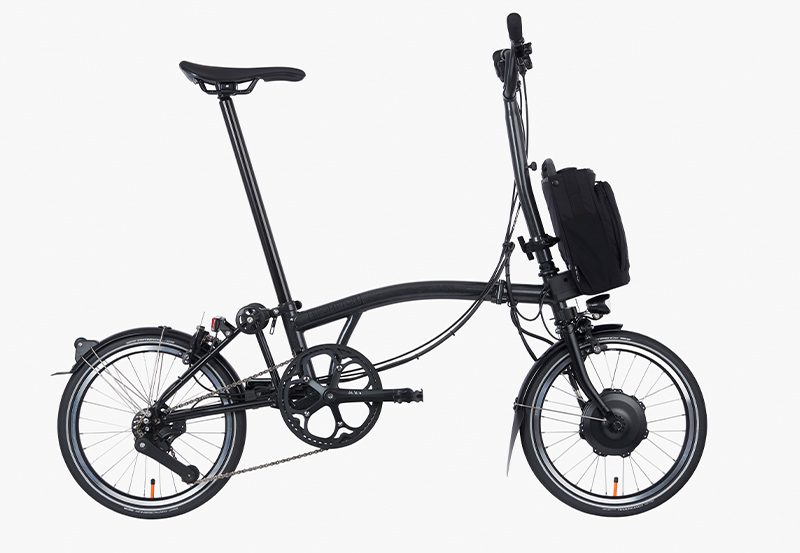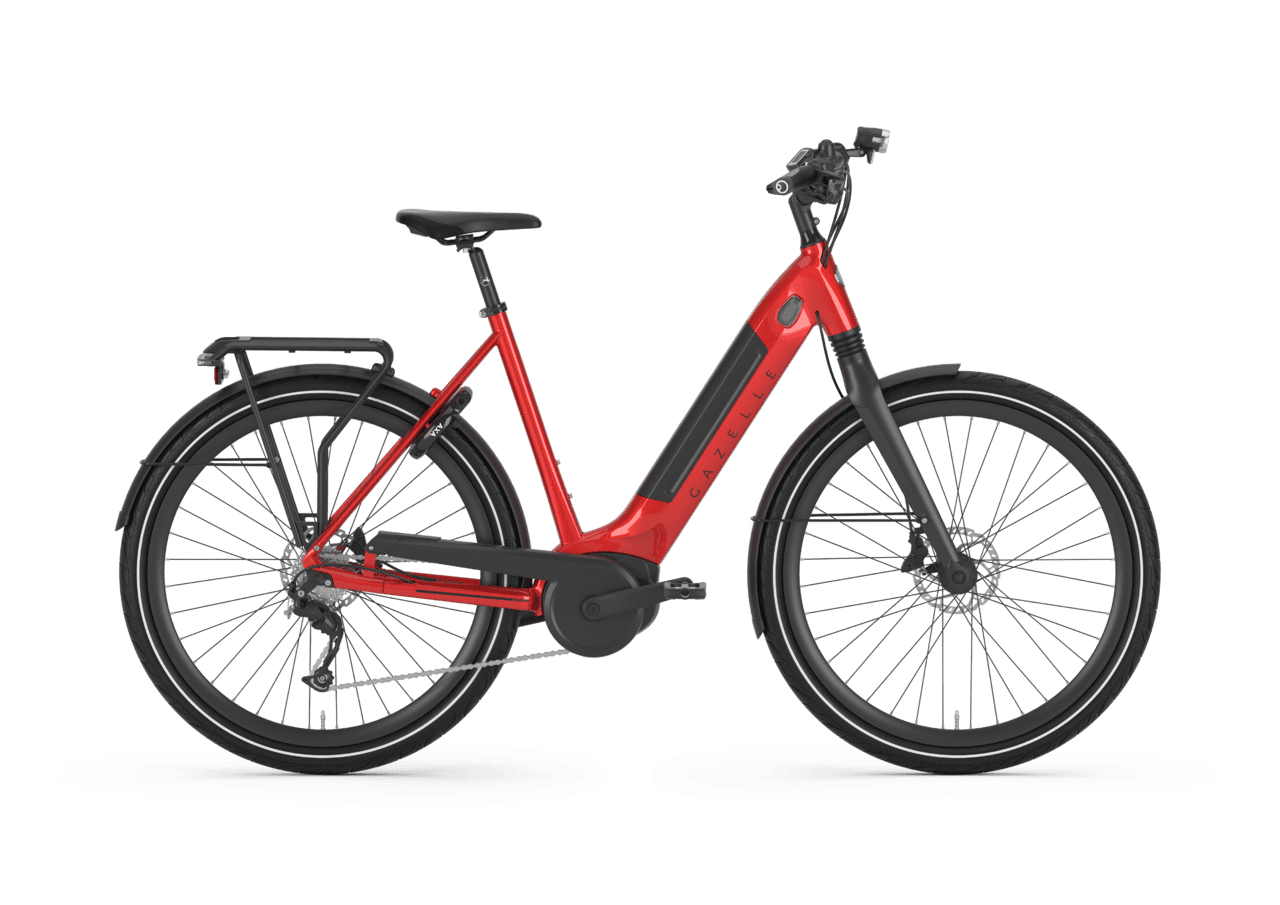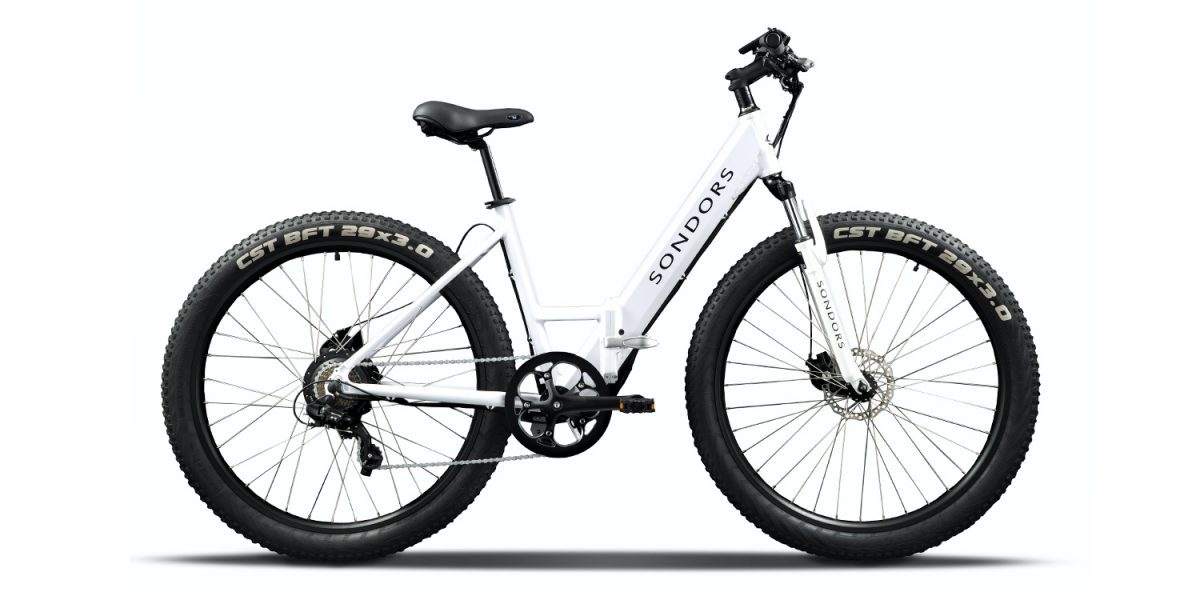What’s The Best Electric Bike for Van Life or On-the-Go Adventures?
What’s The Best Electric Bike for Van Life or On-the-Go Adventures?
Van life / RV Life is all about freedom and adventure, and what better way to explore the great outdoors than on a powered bicycle!? With the rise in popularity of compact and folding style of electric cycles, it’s easier than ever to bring your two-wheeled transportation on the road with you. But with so many options out there, it can be overwhelming to choose the best e-bike for van life.
I had an RV spot on Vancouver Island that was at the top of a huge hill! I wanted to ride my bicycle places, get groceries, go for acupuncture, go to yoga, whatever, but I just couldn’t manage the huge hill every darn time I left my spot. So I began the hunt for the perfect electric bike for my style and life as well as my tiny lifestyle!
It literally took me months of researching before I actually bit the bullet and chose the Sondor’s Smart Step folding E-Bike. I have never regretted it.
When it comes to selecting the best electric bike for van life, there are a few key factors to consider. The first is portability – you want an electric bike that’s easy to store and transport in your van or RV. The second is range – you’ll want an electric bike with a battery that can last for long distances. And finally, you’ll want an electric bike that’s comfortable and reliable for all types of terrain.
Considerations for Choosing an E-bike for Van Life
When it comes to choosing a bicycle for van life, there are several important factors to consider. Here are some things to keep in mind:
Type of Pedal Assist
- Torque sensor: This type of pedal assist system measures the amount of force you are applying to the pedals and adjusts the motor output accordingly. The harder you pedal, the more power the motor provides. This type of system provides a more natural riding experience and is ideal for those who want to feel like they are doing the majority of the work.
- Cadence sensor: This type of pedal assist system measures the speed at which you are pedalling and adjusts the motor output accordingly. The faster you pedal, the more power the motor provides. This type of system is less sophisticated than a torque sensor, but it is less expensive and still provides a decent riding experience.
- Combined sensor: This type of pedal assist system uses both torque and cadence sensors to provide a more accurate and responsive ride. The system measures both your pedalling force and speed and adjusts the motor output accordingly. This type of system is more expensive than the other two, but it provides the most natural and intuitive riding experience.
Battery Life
One of the most important things to consider when choosing the best electric bike for van life is battery life. You want to make sure that the bike battery will last long enough to get you where you need to go without needing to be recharged too frequently. Look for electric bikes with batteries that have a range of at least 40 miles per charge.
You might want to also consider picking up a second battery if you plan on going on any epic adventures. Of course, this would add a significant amount to your purchase price, but for life on the road, it’s often a smart idea to have a backup power source. I’d also recommend having a portable power bank so you can charge your E-bike while you’re on the road. Read my blog post about what different options are out there for portable power.
Weight
Another important consideration is the weight, the weight is an important factor to consider when choosing any type of bicycle for several reasons:
- Maneuverability: A heavy bicycle can be difficult to maneuver, particularly when navigating tight corners or when parking the bike. This can be especially challenging for riders who are less physically strong.
- Battery Life: The weight of the e-bike can also impact its battery life. The heavier the bike, the more energy is required to move it, and this can lead to a reduction in the overall distance that the bike can travel on a single charge.
- Transport: If you need to transport your e-bike, a lighter-weight bicycle is much easier to transport, particularly if you need to lift it onto a bike rack or carry it upstairs.
- Comfort: Riding a heavy bicycle can be more tiring and less comfortable for longer distances. With or without pedal assist.
- Safety: A lighter bicycle can be easier to control, particularly at higher speeds, which can improve rider safety.
Since you’ll be storing the bike in your van when not in use, you want to make sure that it’s lightweight enough to be easily lifted in and out of the van. Look for bicycles that weigh less than 50 pounds. My Sondors Smart Step is not light! It’s not light at all, I sacrificed weight for style and tire size. Of course, removing the battery and front tire makes it a significantly lighter bike. There is no way I could carry it up stairs daily!
Weight is also a factor when it comes to a rack for your new ride. You need to make sure you pick up a rack that can hold the weight of your bicycle safely and securely.
Folding Capability
If you’re short on storage space in your van or RV, you may want to consider choosing one that can be folded up for easy storage. Look for a bicycle with folding capabilities that make them easy to pack away when not in use.
A folding electric bike can be an excellent option for van life for several reasons (check out our related post about fitness in small spaces). Firstly, the compact size and foldable design make it easy to store the bicycle in a limited space, which is crucial when living in a van. Folding e-bikes can fit into small spaces, such as under a bed, in a closet, or even in the trunk of a car, freeing up valuable space for other necessities.
Secondly, a folding e-bike is often lighter than a traditional electric bike, making it easier to transport and maneuver. This is particularly beneficial if you plan to use your bike for exploring new places or navigating challenging terrain, such as hilly areas or off-road trails. The reduced weight also means you can load it onto a bike rack or carry it inside the van without adding too much extra weight.
Finally, a folding bicycle can be a cost-effective option, especially when compared to larger electric bikes. While some folding e-bikes can be expensive, they can often be less expensive than larger models with similar features and specifications. This can be particularly attractive for van life enthusiasts who may be looking to reduce their overall expenses and live a more minimalist lifestyle.
I chose the Sondors step because it folds. I had a kia soul at the time and it would fit quite nicely into the trunk of that little toaster of a car.
I had a special box built for it that will attach to my trailer hitch tube so that I can pack it around on the back of my Van or my motorhome. A folding e-bike should definitly be accompanied by a folding bike helmet! Read my post about the best folding bike helmets here.
Tire Size
The size of the tires on any bicycle is an important factor to consider when living the van life. This is because larger tires can offer better stability and traction on rough terrain, making it easier to navigate through different environments. Additionally, larger tires can absorb more shock and provide a smoother ride on bumpy or uneven roads.
On the other hand, smaller tires can be more convenient for storage in a van since they take up less space and are lighter. They can also be easier to maneuver in tight spaces or when carrying the bike in and out of the van.
Ultimately, the size of the tires on your bicycle will depend on your individual needs and preferences for van life. If you plan to do a lot of off-road or rough terrain riding, larger tires may be a better choice. However, if you prioritize space-saving and portability, smaller tires may be a better fit.
Braking Systems
There are different types of braking systems for all bicycles. Some of the most common types include:
- Rim Brakes: These are the most basic type of brakes and are commonly found on entry-level bicycles. They work by pressing brake pads against the rim of the wheel to slow down or stop the bike.
- Disc Brakes: These are the most popular type of brakes as they offer better stopping power and are more durable than rim brakes. They work by using a calliper to squeeze brake pads against a rotor attached to the wheel.
- Hydraulic Disc Brakes: These are similar to disc brakes, but instead of using a cable to activate the brake, they use hydraulic fluid. This provides more consistent braking and requires less effort from the rider.
- Coaster Brakes: These are typically found on cruiser-styles and work by pedalling backwards to engage the brake. They are simple and low-maintenance but do not provide as much stopping power as other types of brakes and might not be the best for a heavy bicycle whether electric or human powered.
- Regenerative Brakes: Some are equipped with regenerative braking systems, which use the motor to slow down the bike and also recharge the battery. This can help extend the range of the e-bike and reduce wear on the brake pads.
Each type of braking system has its own advantages and disadvantages, and the choice of brake system depends on the type of riding the e-bike is intended for and the preferences of the rider.
Price
Finally, consider the price. While you don’t want to skimp on quality, you also don’t want to overspend on a bike that’s beyond your budget. Look for an electric bike that offers a decent balance of quality and affordability. I chose my bike based on all the factors but the price was really a deciding factor for me, My bike was under 1000$ US at the time I bought it but it sells for 1600 now. E-bike prices are escalating just like everything else in life!
Top E-bikes for Van Life
When it comes to choosing the best electric bike for van life, there are a few key factors to consider. You’ll want a bike that’s lightweight, compact, and easy to store in your van. It should also have a long battery life and be able to handle a variety of terrain.
After researching and testing various rides, the internet and I narrowed down the top options for van life:
- Brompton Electric: This folding style is perfect for van life as it can easily be stored in a small space. It has a range of up to 50 miles and can reach speeds of up to 15 mph. They claim to be the worlds smallest folding electric bike weighing in at 12.7kg/27.99lbs without the battery. Mid-range price point. 5.6ah. 4 hour charge time. 10-40 mile range. Lifetime Frame, 1 Year Motor, 6 Month Battery warranty.

Brompton Electric
- Tern GSD S10: This space saving electric cargo bike is great for hauling gear and supplies in and out of your van. It has a range of up to 69 miles and can carry up to 375 pounds. Not as compact and foldable due to it being a cargo style, as the other brands we looked at. mid-high price point. 67lbs. 11ah. 10-75 mile range. 2 Year Electronics and Battery, 5 Year Frame.

Tern GSD S10
- Gazelle Ultimate T10: This versatile ride is ideal for exploring different terrain. It has a range of up to 60 miles and can reach speeds of up to 28 mph. This ride can go the farthest on it’s battery life.. Bigger wheels and a mid range price point. 57.3lbs. 13.4ah. 4 hour charge time. 30-120miles. 2 Year Comprehensive, 10 Year Frame warranty.

Gazelle Ultimate T10
- Rad Power Bikes RadRunner 3plus: This somewhat more affordable electric bicycle has a range of up to 45 miles and can carry up to 300 pounds. The rear rack can hold up to 120lbs. They make a folding model that has a more compact size making it easy to store in your van. Fat tires but smaller than the standard wheel size. 75.5lbs. 14ah. 6 hour charge time. 25-45 mile range. 1 Year Comprehensive warranty.

Rad Power Bikes Rad Runner
- Sondors Easy Step: The bike I chose after months of research. Folding, has big tires, a step-through cruiser style, and you can’t tell if it’s an electric bike. I found this to be the most affordable electric bike at the time I was in the market for one. 55.6 lbs. 10.4 ah battery. 4hour charge time. 20-30mile range. 1 Year Comprehensive warranty.

Sondors Smart Step
Ultimately, the best wheels for van life will depend on your specific needs and preferences. Consider factors such as range, weight, and storage when making your decision. I wanted something I could use on the sandy trails in Mexico, I wanted something I was proud to ride, I wanted something that could fold up for storage. I wanted a compact bicycle that still had a bit of curb appeal.
Pros and Cons of Each E-bike
When deciding on the best electric bicycle for van life, it’s important to consider the pros and cons of each option. It’s important to note that there are folding options in almost all of the different types listed below. I still really like my Sondors step. I get a lot of compliments on it, it will take me anywhere, I do still have to pedal though it’s not a motorbike! Here are some key factors to keep in mind:
Electric Mountain Bikes
Electric mountain bikes, or eMTBs, are designed to provide an extra boost to riders as they tackle rugged terrain and steep inclines. These rides typically feature a sturdy frame, full suspension, and knobby tires for improved traction. With the help of a powerful electric motor and battery, riders can climb hills with ease and tackle technical sections with confidence. Many eMTBs also come equipped with advanced features such as adjustable suspension, hydraulic disc brakes, and intuitive controls. Whether you’re an experienced rider looking for a new challenge or simply looking to explore the great outdoors, an eMTB can provide an exhilarating and rewarding experience.
- Pros:
- Great for off-road adventures and tackling steep hills
- Typically have larger tires for better traction and stability
- Offer a more traditional bike riding experience with the added boost of electric power
- Cons:
- Can be heavy and difficult to transport in a van or RV
- May not be as comfortable for long rides on paved roads
- Can be more expensive than other e-bike options
Folding Electric bikes
Folding electric bikes are a popular choice for commuters and van lifers who are short on space or need a bicycle that can easily be stored in a small living area or vehicle. These bikes are designed with a folding frame and components that allow them to be compacted into a smaller size, making them ideal for storage in a closet, car trunk, or even under a desk. With a powerful electric motor and pedal assist system, e-folding bikes can handle hills and longer commutes with ease, while still offering the convenience and portability of a folding bike. Overall, folding electric bicycles are a versatile and practical option for those seeking an efficient and space-saving mode of transportation.
- Pros:
- Compact and easy to store in a small space, making them ideal for van life
- Lightweight and easy to transport
- Can be used for both on-road and off-road adventures
- Cons:
- May not be as comfortable for long rides due to smaller wheels and frames
- Usually have a lower weight capacity than other bicycles
- May not be as durable as other ebike options
Cargo E-bikes
Cargo e-bikes are specifically designed for carrying heavy loads and transporting goods, making them a popular choice for urban commuters and businesses. These bikes have sturdy frames, wide tires, and powerful motors that allow riders to effortlessly transport large items, such as groceries or packages, without the need for a car. They also typically have large, flat cargo areas or baskets attached to the front or back of the bicycle for carrying items. Cargo e-bikes come in a variety of styles, including longtail, which has an elongated frame and cargo area behind the rider, and midtail, which has a shorter frame but still provides ample cargo space. With their practical design and ability to replace a car for short trips, cargo e-bikes are becoming increasingly popular for their sustainability and convenience.
- Pros:
- Designed for carrying heavy loads, making them ideal for van life
- Can be used for both on-road and off-road adventures
- Offer a comfortable and stable ride
- Cons:
- Can be heavy and difficult to transport on a van or RV
- May not be as maneuverable as other e-bike options
- Can be more expensive than other e-bike options
Ultimately, the best bicycle for van life will depend on your individual needs and preferences. Consider factors such as weight, size, and intended use when making your decision.
Security
When it comes to van life and travelling, security is an important consideration. When you’re out exploring, you want to make sure your electric bicycle is safe and secure. One way to protect your ride is to invest in a quality lock. Look for a lock that’s sturdy and durable, and make sure it’s large enough to fit around the frame of your bike and a secure object. You can also consider adding an alarm system to your bike lock for added security.
In addition to securing your expensive wheels, it’s also important to take steps to protect yourself and your belongings while on the road. This includes being aware of your surroundings and taking precautions such as parking in well-lit areas and locking your doors at night. Investing in a good quality GPS tracker for your bicycle and other valuables can also provide added peace of mind. By taking these steps, you can enjoy your van life or on-the-go adventures with the confidence that your bike and belongings are secure.
Storage
Having good storage for your ride is important for both transporting and storing it.
When it comes to transporting your bicycle, proper storage can help prevent damage to the bike and ensure that it stays secure while in transit. Without proper storage, the bike can move around and potentially scratch or dent other items in your vehicle or even damage itself. Good storage options can also make it easier to load and unload the bike from your vehicle.
In terms of proper storage, this can help protect it from the elements and keep it in good condition. This is especially important if you plan to store it for an extended period of time, such as over the winter months. Good storage options can also help prevent theft, as they can be locked or secured in a safe location.
- Wall mounts: Wall mounts can be a great option if you want to keep your bicycle off the ground and out of the way. These mounts attach to the wall of your van and allow you to hang your bike vertically, saving space.
- Bike racks: Bike racks are a popular option for those who want to transport their e-bikes on a vehicle. There are many types of bike racks available, including hitch-mounted, roof-mounted, and trunk-mounted.
- Bike covers: Bike covers can be useful for protecting it from the elements when it’s being stored outside. They can be made from a variety of materials, such as polyester or nylon, and are designed to fit snugly over your bike.
- Bike lockers: Bike lockers provide a secure storage option for e-bikes. These lockers are typically located in public places, such as transit stations or parking garages, and can be rented for a fee.
Proper Care and Maintenance
Electric bikes are a great way to get around, offering an environmentally friendly and cost-effective alternative to driving. However, like any other vehicle, they require regular care and maintenance to keep them running smoothly and extend their lifespan.
One of the most important things you can do is to keep it clean. Dirt and grime can build up on the bike’s components, causing them to wear down faster and reducing their efficiency. To clean your bike, use a soft brush or sponge and mild soap and water. Avoid using a high-pressure hose or spraying water directly onto the electrical components, as this can damage them.
Another important aspect of bicycle maintenance is keeping the battery charged. Most electric bike batteries will last for several years with proper care, but they do need to be charged regularly to maintain their health. Be sure to follow the manufacturer’s recommendations for charging your bike’s battery, and avoid overcharging it or letting it run completely dead.
In addition to regular cleaning and battery maintenance, it’s also a good idea to have your bike serviced by a professional on a regular basis. A professional bike mechanic can check for any wear and tear on the bike’s components and make any necessary repairs or replacements. This can help prevent more serious issues down the line and keep your bike running smoothly for years to come.
Overall, taking good care of your electric bike is essential to keeping it running smoothly and extending its lifespan. By keeping it clean, maintaining the battery, and having it serviced regularly, you can ensure that you’ll be able to enjoy your bike for many years to come.
Final Thoughts – Best Electric Bike For Van Life
Choosing the best electric bicycle for van or RV life can be a daunting task, but hopefully, this guide has given you some helpful information to make an informed decision. Remember to consider your specific needs and preferences when selecting an e-bike.
If you prioritize portability and compactness, the folding electric bikes like the Brompton Electric and the Gocycle may be the best options for you. On the other hand, if you want a more resonably priced and versatile e-bike, the Rad Power Bikes RadRunner or the Gazelle Ultimate T10 may be more suitable. I wanted a combination of all elements, distance, price, foldability, looks, so I went with the Sondors. If I were doing it all over again, I would likely choose the Sondors Smart Step. I truly do love my bicycle.
It’s also important to keep in mind your budget and the cost of maintenance when choosing an e-bike. While some models may be more expensive upfront, they may save you money in the long run with their durability and reliability.
Ultimately, the best e-bike for van life is the one that meets your unique needs and preferences. Do your research, test ride different models, and choose the electric bicycle that will enhance your van life experience and allow you to explore more freely.
What kind of bike do you have in your tiny home one wheels? Comment below, I’d love to know what you chose and why! I’d love to be able to add to the list a few more choices for my readers.







